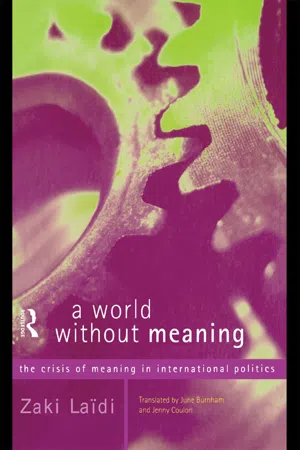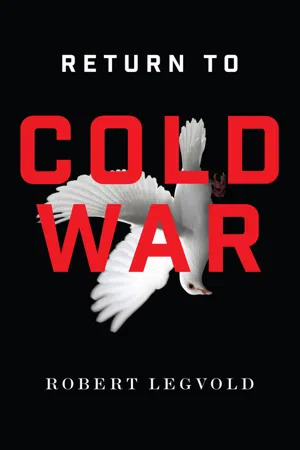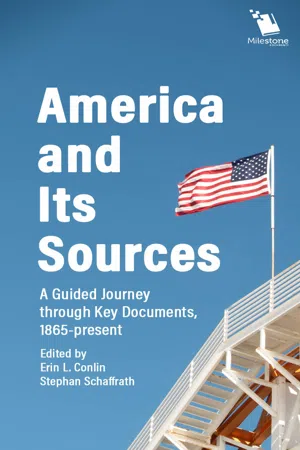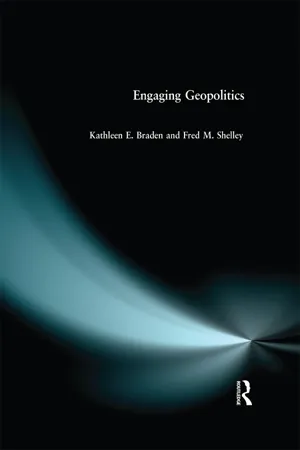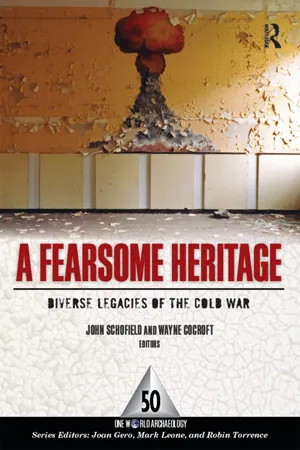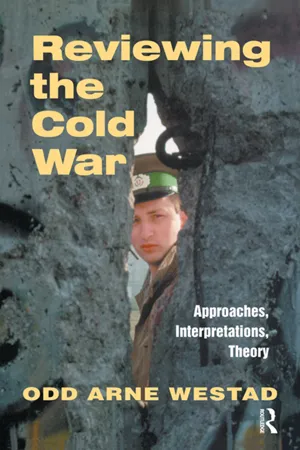History
Cold War
The Cold War was a period of geopolitical tension and rivalry between the United States and its allies on one side, and the Soviet Union and its allies on the other, following World War II. It was characterized by ideological, political, and military competition, but without direct armed conflict between the two superpowers. The Cold War had a significant impact on global politics and international relations.
Written by Perlego with AI-assistance
Related key terms
10 Key excerpts on "Cold War"
- eBook - ePub
A World Without Meaning
The Crisis of Meaning in International Politics
- Zaki Laidi(Author)
- 2005(Publication Date)
- Routledge(Publisher)
1The meaning of the Cold WarThe more the Cold War fades into the distance, the more we shall be obliged to think of it, re-read it and reinterpret it not only geopolitically but also in cultural terms. We shall discover—doubtless risking over-rationalization of the past— how original this moment in history was in the way it was able, over an exceptionally long period, to reorder the main world issues around a battle for the appropriation of meaning. Within half a century the Cold War managed to ‘encompass’ very large-scale political, economic, social and cultural transformations: the decolonization of the Third World, the growth in economic power of Japan and Germany, the Sino-Soviet split, and the proliferation of bloody regional conflicts. It also managed to incorporate economic and sociological realities as fundamental as the decline of the industrialization strategy to the advantage of the service sector, the erosion of the Keynesian model, the blossoming of individualist values, the development of mass culture and the subsequent atomization of demands.1A ‘tragic system’
But this ‘moment in history’ was not restricted to channelling the shifts in world power or conscientiously fanning regional conflicts. It enabled the pursuit, strengthening and perhaps completion of the long, slow, linear process of the historical transfer of meaning that, over the centuries, had fixed itself in succession on religion, nationalism and finally ideology, that great ‘mythogenous’ factor of the twentieth century.2 Indeed, it managed to combine two absolutes: meaning, symbolized by the ideological combat between two universal and competing value-systems; and power, carried by the absolute weapon, the nuclear bomb.Between 1917 and 1945, all the seeds of an ideological confronta tion had unquestionably been sown. At the same time as the Bolsheviks were seizing the Winter Palace, the American president, Woodrow Wilson, was already drafting the contours of a new order that could raise aloft the flag of democracy in the world.3 - eBook - ePub
- Robert Legvold(Author)
- 2016(Publication Date)
- Polity(Publisher)
Like any large, complex phenomenon, there are multiple ways to understand the Cold War. Two, however, help better than others to unscramble the tangle of interpretations vying to explain the new Cold War. The first is the venerable and widely accepted conviction that the Cold War was a battle between political and economic systems, underpinned by fundamentally different values, goals, and ontologies. Within this argument the principal contention was over the latter, over the ideological element, and whether it played a primary or secondary causal role. Less conspicuously, a second area of disagreement eventually emerged related to the primary sphere within which the inter-systemic rivalry took place. Scholars looking back over the whole of the Cold War charged that mainstream analysts, particularly international relations theorists, had gotten it wrong by stamping it Euro-centric – that is, as a strategic contest between the United States and the Soviet Union over the fate of the international system’s European fulcrum – when, in fact, the Cold War’s active theater was the Third World (Westad, 2007).If the Cold War, as Fred Halliday (1999) argued, was as much a socio-economic contest for the hearts and minds of much of the globe as an ideological and geopolitical test of wills, then the fluid environment where it raged and, indeed, the point from which it ricocheted back into the anxiety-ridden consciousness of US and Soviet leaders was the vast expanses of a roiling postcolonial world. Halliday, to put a fine point on it, suggested that US “national security doctrines – from Truman to Reagan – were less about responding to Soviet geopolitical maneuvering and more concerned with responding to the geopolitical consequences of localized revolutionary crises” (Saull, 2011).That was inside the argument. Outside of it, the opposing school insisted that the clash of political and economic systems mattered less than a simple, classical slugfest over power. The clash was merely the tissue covering the real muscle controlling events. Beginning with this elemental argument, all of these contested byways echo today. Thus, some argue that the trouble traces back to the wildly different assumptions motivating the two sides. From the Western perspective, everything begins with the red in tooth and claw determination of Russian leaders to reverse the loss of place and power following the collapse of the Soviet Union. From a Russian perspective, the root cause is in the (unexplained) determination of US leaders to diminish Russia and put it in a box. It is a simple struggle for power, and these are its terms. - eBook - ePub
War, Peace and International Relations
An introduction to strategic history
- Colin S. Gray(Author)
- 2013(Publication Date)
- Routledge(Publisher)
14 The Cold War, I
Politics and ideologyReader's guide: The legacy of World War II. The onset of the Cold War. The course of the conflict. Soviet and US performance. Soviet failures.Introduction: from war to peace – the consequences of World War II
The Cold War has passed into history, but the nuclear bomb and the nuclear revolution are here to stay, prospectively for ever. Between them, the bomb and the political context of the Cold War nearly brought strategic history to an abrupt full stop. The human experience in its entirety might well have been concluded violently. How did this happen? And, more to the point, why? This chapter offers a fresh look at the Soviet–American Cold War of 1947–89, while the chapter that follows pays particular attention to its historically novel nuclear dimension.The events and non-events, but possible events, of the Cold War years comprise a contested history among scholars today (Westad, 2000; Herrman and Lebow, 2004). Almost everything about the Cold War is uncertain; at least, it is uncertain if one focuses on issues of motivation and causation. There is no solid consensus on why the Cold War began, who was most responsible for it, or why it concluded with barely a whimper with the loss of the will to power of the Soviet ruling elite in the late 1980s. Fortunately, the historical record provides some compensation for the deeper uncertainties. Even if one cannot be sure exactly why particular decisions were taken, one can secure an adequate grasp of who did what and when. Furthermore, one can proceed to ask and answer the strategist's question: so what? Deeds and their consequences are less mysterious than are motives.One of the themes of this text is the intimate connection between war and peace, and indeed between peace and war. Peace, at least some semblance thereof, follows war. Moreover, peace of a particular character is what a war is all about. It is easy to forget this fundamental fact amid the stress, excitement and difficulties of waging war. The Cold War was a consequence of the changes in context produced by World War II. It is vital to recognize the complex authority of context. It is not quite everything, because individuals matter. But the Stalins, Kennedys and Gorbachevs must exercise their judgement, their somewhat free will, in political, socio-cultural, economic, technological, military–strategic, geographical and historical contexts for which they are largely not responsible. - eBook - ePub
America and Its Sources
A Guided Journey through Key Documents, 1865-present
- Erin L. Conlin, Stephan Schaffrath(Authors)
- 2019(Publication Date)
- Schlager Group Inc.(Publisher)
8. 1 The Cold WarOverviewUnit 7, World War II and the Home Front, concluded by introducing post-war tensions that set the United States and the Union of Soviet Socialist Republics (USSR or the “Soviet Union”) on a path that changed the course of history. The ideological divide between the two nations—the United States promoting capitalism and democracy and the Soviet Union supporting communism—defined one of the most tense periods in world history.The readings in this unit illustrate how the conflict developed and played out over time. The Cold War began almost immediately after World War II and lasted until 1991, when the Soviet Union collapsed. For nearly 45 years the United States and the Soviet Union were locked in a largely ideological struggle. Proxy battles occurred in places like Korea and Vietnam, and the two nations nearly engaged in a direct conflict during the 1962 Cuban Missile Crisis; but overall, the two world superpowers successfully avoided direct military confrontation, thus earning the period the name the “Cold War.” To understand this period, you have to understand the key vocabulary, concepts, and major players.Capitalism is based on free markets (with no or limited government regulation) and private ownership of the means of production. The government generally embraces a hands-off approach to the economy. The government may provide some basic regulations, but it does not generally own the companies that produce goods or provide utilities. Likewise, workers own their own labor and can negotiate for wages with their employer. Under a communist system, the government owns the means of production and establishes the wage rates for workers based on their abilities and needs. Communism rejects private property ownership because it creates inequality among the population (social, political, and economic). Communists strive to create a society where all people are treated equally. Karl Marx is considered the father of modern communism. - eBook - ePub
- Kathleen E Braden, Fred M Shelley(Authors)
- 2014(Publication Date)
- Routledge(Publisher)
3The Cold War
KEYWORDS
blocs, domino theory, containment,détente ,glasnost, shatterbelt, non-alignmentKEY PROPOSITIONS
• New war-fighting technologies and the Soviet/American rivalry dominated post-World War II geopolitical discourse through the 1980s.• The locus of this conflict increasingly shifted to a third world stage and to four major shatterbelt areas.• Europe perceived itself as a buffer between two superpowers, a fact that helped the formation of a European Union.3.1 Introduction
The end of World War II in 1945 brought about substantial and profound changes in international relations. Since the Renaissance, the world economy had been centered in Europe, and geopolitical theory was concerned primarily with European states and their interrelationships. The conclusion of World War II signified that Europe was no longer at the center of the global political economy. After the war, the United States and the Union of Soviet Socialist Republics emerged as the world’s leading powers, while the countries of Europe were dependent on American and Soviet aid to rebuild their war-torn and devastated economies.Conflict between the Americans and the Soviets soon dominated geopolitical thought. Within a very few years, geopolitical and ideological differences between America and Russia were to divide Europe and initiate the Cold War. Sir Winston Churchill’s famous phrase, “an iron curtain has descended across the continent” came to symbolize Europe’s position in post-World War II geopolitics. Europe was no longer in a position to initiate geopolitical change; rather it was a potential battleground, both militarily and economically, between the competing interests of the United States and the Soviet Union. By the 1950s, Western Europe had become incorporated into the American-dominated North Atlantic Treaty Organization (NATO), and thousands of American troops were stationed in Germany and elsewhere in Europe with the intention of protecting Western Europe from potential Russian attacks. Similarly, the Warsaw Pact symbolized the incorporation of Eastern Europe into the Soviet sphere of influence. - eBook - ePub
The Cold War
An International History
- David Painter(Author)
- 2002(Publication Date)
- Routledge(Publisher)
2 The Cold War begins, 1945–50Following World War II, the foreign policies of the United States and the Soviet Union interacted with the chaotic and fluid state of international relations to produce the Cold War. Understanding the impact of World War II on the international system and its members is crucial to understanding the origins of the Cold War. World War II accelerated fundamental changes in the global distribution of power, in weapons technology, in the balance of political forces among and within nations, in the international economy, and in relations between the industrial nations and the Third World. In addition, the diplomatic and military decisions made during the war had a profound impact on the shape of the postwar world.THE WORLD IN 1945
World War II was the culmination of a series of events that profoundly changed the global distribution of power. As National Security Council Paper No. 68, the seminal statement of US Cold War policies, pointed out in April 1950, “within the past thirty-five years the world has experienced two global wars of tremendous violence…two revolutions—the Russian and the Chinese—of extreme scope and intensity …the collapse of five empires—the Ottoman, the Austro-Hungarian, German, Italian, and Japanese—and the drastic decline of two major imperial systems, the British and the French.” The result was the end of the European era and the rise to dominance of two continental-size superpowers, the United States and the Soviet Union.1Before World War II there were six great powers: Great Britain, France, Germany, the Soviet Union, Japan, and the United States. The United States entered the postwar era in a uniquely powerful position, its relative standing greatly increased by its mobilization and war effort, its allies exhausted, and its rivals defeated. Around 410,000 US citizens lost their lives in the war, but US farms, factories, mines, and transportation networks escaped unscathed. Wartime mobilization and production lifted the United States out of the depression, and during the war the US economy almost doubled in size. In 1945, the United States controlled around half the world’s manufacturing capacity, most of its food surpluses, and a large portion of its financial reserves. The United States also held the lead in a wide range of technologies essential to modern warfare. Possession of extensive domestic energy supplies and control over access to the vast oil reserves of Latin America and the Middle East further contributed to the US position of global dominance. - eBook - ePub
- John Mueller(Author)
- 2013(Publication Date)
- Cornell University Press(Publisher)
It even began to be possible that the United States and the USSR could again become allies as they had been during World War II. In 1988, in his last presidential press conference, Ronald Reagan was specifically asked about this, and, stressing the ideological nature of the contest, he responded essentially in the affirmative: “If it can be definitely established that they no longer are following the expansionary policy that was instituted in the Communist revolution, that their goal must be a one-world Communist state…[then] they might want to join the family of nations and join them with the idea of bringing about or establishing peace.” In the spring of 1989, his successor, George Bush, was repeatedly urging that Western grand strategy should change, moving “beyond containment” to “integrate the Soviet Union into the community of nations.” 35 Thus, judging from the rhetoric and actions of important observers and key international actors like these two presidents, the Cold War ended in the spring of 1989. 36 This timing strongly suggests that the Cold War was principally an ideological conflict in which the West saw the Soviet Union as committed to a threateningly expansionary doctrine. Once this menace seemed to vanish with the policies of Gorbachev, Western leaders and observers began to indicate that the conflict was over. Thus the Cold War was not about the military, nuclear, or economic balance between the East and the West, nor was it about Communism as a form of government, the need to move the world toward democracy and/or capitalism, or, to a degree, Soviet domination of Eastern Europe. * The Cold War was not about these issues because it came to an end before any of them was really resolved. The process can be neatly summarized with some public opinion data. Figure 2 (p - eBook - ePub
A Fearsome Heritage
Diverse Legacies of the Cold War
- Dr John Schofield, Wayne Cocroft(Authors)
- 2016(Publication Date)
- Routledge(Publisher)
Residents of Greenham Common often sided with the authorities, not necessarily in support of military policy but because they objected to the presence and goals of the peace camp inhabitants on a range of political grounds, from gender to political outlook to lifestyle, that were not necessarily connected at all to Cruise missiles. After all, they had lived next to the base, in its successive incarnations, all their lives. Opposition to the peace camp among this group did not necessarily mean that they supported the government’s nuclear policies, of course: the mixture of motives and opinions was far more complex. Some of the conflict continued after the base was abandoned, and carried on, transmuted, into the debate about the site’s future – housing, industrial park, monument, nature reserve. It still remained a contested place after Cruise left. Greenham – at its widest – might have been the perfect place for an anthropological deconstruction of tribalism and ethnicity among the English, notorious as they are becoming for their lack of defined self-identity. To contain all this within simply a military view of the Cold War would seem to be misguided.History, it is said, is written by the victors. Perhaps so, but archaeology need not be so directed. Who, anyway, were the victors? There is a political and economic elite in Russia now who wouldn’t have power and wealth without the ‘defeat’ of the 1980s. Judged by the shift of, for instance, the USA’s foreign policy attention since 1991 towards countries that weren’t involved in the Cold War, maybe such countries were beneficiaries of the Cold War (which balanced USA power with that of the USSR, achieving a stasis for a time: the MAD thesis, now apparently deemed obsolete), but were these same countries also losers once the Cold War ended? It has been noticed that the success of more left-wing parties in most of the recent elections in South America might be a reflection of Washington’s foreign policy preoccupation with the Middle East oil countries. Here would be another arena for interrogating material culture of all types.The Cold War has also been called the third chapter in the 20th-century European Civil War. Some military material culture shows the seamless transitions from war to war (such as anti-aircraft technology from the Second World War into the Cold War, and the use of Spain as a technological rehearsal for the Second World War and an ideological rehearsal for both the Second World War and the Cold War). Since all three ‘chapters’ in Europe were brought to their conclusion (‘won’, I could say, being born in the UK) by USA investment of people and resources, the question of where the two Gulf wars and Afghanistan fit must come to the fore. Is the War on Terrorism in part the next stage of an episodic conflict (Cold War II, in the language of Hollywood sequels), a long-term conflict reflecting the need of governments (and societies) to ensure national and social coherence through the creation of strongly defined enemies? It has been noticed by many journalists that the current White House seems to use the word battle not war - eBook - ePub
Over the Horizon
Time, Uncertainty, and the Rise of Great Powers
- David M. Edelstein(Author)
- 2017(Publication Date)
- Cornell University Press(Publisher)
CHAPTER 5The Origins of the Cold War
This chapter examines the dynamics of emerging threats in an environment where other threats were absent. During World War II, the pressing threat of Nazi Germany and imperial Japan produced short time horizons and the mutual benefits of cooperation for the Allied powers. At the end of World War II, time horizons became elongated, and competition resulted. The United States was by any measure the most powerful country in the world after World War II. Given the small short-term rewards for cooperation, the absence of alternative threats, and growing concern about long-term Soviet intentions, the United States transitioned from the cooperation that characterized World War II to the competition that characterized the Cold War. As much as emerging bipolarity set the stage for the Cold War, it was U.S. beliefs about long-term Soviet intentions that explain the timing and emergence of the conflict. While the United States might have preferred to come home after the conclusion of World War II, growing concern about Soviet intentions made that impossible.1 To be clear, U.S. behavior was not blameless in the origins of the conflict, but this chapter aims to provide a better understanding of how the United States came to regard the threat posed by an emerging postwar Soviet Union.This chapter serves a different purpose than the other empirical chapters. It is not surprising that the United States and the Soviet Union found value in a marriage of convenience to defeat Hitler’s Germany. What this case does allow for is a more careful examination of the role that beliefs about intentions, rather than simply capabilities, play in resolving uncertainty about the threat posed by a rising power. While there is no denying that the structural environment of bipolarity after World War II made Soviet-U.S. competition more likely, this chapter demonstrates that it was increasing evidence of Soviet intentions that was the driving force behind the evolution of U.S. strategy toward Moscow. The United States was not overly concerned by the immediate military threat that Moscow posed to Western Europe. In fact, Washington’s inclination was to pull back and come home once the war had concluded. But ominous signals of Soviet intentions added to the weight of the evidence supporting a reasonable probability that the Soviets did, indeed, pose a threat. It was beliefs about intentions and the transformation of uncertainty into risk that generated the Cold War. - eBook - ePub
Reviewing the Cold War
Approaches, Interpretations, Theory
- Odd Arne Westad(Author)
- 2013(Publication Date)
- Routledge(Publisher)
The standard arguments add up to skepticism about the implications of the new evidence, but they are insufficient to explain international relations scholars' approach to it. They would come into play only if the relationship between contending theories and the explanation of the Cold War were evident. If the theoretical stake in explaining the Cold War were clear, scholars would have no choice but to treat new evidence about the Cold War explicitly. If they did so, all the arguments about causal inference, biased interpretation, ambiguous evidence, and the limits of the new material would apply — just as similarly challenging methodological arguments apply to other kinds of evidence and other sorts of tests. To understand the field's unstudied indifference, it is necessary to look beyond the universal challenges of scientific inference, and even the specific difficulties of studying world politics, to three particular pathologies that conspire to confound the relationship between historical evidence and the evaluation of IR theories.First is ambiguity about history. All too often, the relationship between theories or theoretical debates and the explanation of specific historical episodes is profoundly ambiguous. True, by the 1980s, many of the central debates quite clearly had nothing to do with the Cold War. In the long-running debate between neo-liberal theories and Kenneth Waltz's Neo-Realism, for example, the former simply conceded the Cold War as a topic to the latter. Much of the debate in those years centered on explaining cooperation among capitalist states. Scholars argued over the likely effects of US decline — without explicitly considering the US—Soviet rivalry. In keeping with this arrangement, the current attack on Neo-Realism focuses (with a few exceptions) on post-Cold War developments rather than on retrospective explanations of the Cold War itself.10However, even when theories and theoretical arguments do seem related to the Cold War, the extent to which they are sensitive to our understanding of that event is shrouded in ambiguity. The culprit here is the scholarly aspiration to universalism. International relations theories are written to explain relations among states in all times and places. As a consequence, the degree to which their validity hinges on the explanation of any one episode is always unclear. For this reason, ‘critical cases’ — that is, events that must conform to a theory's expectations if that theory is true — never occur in international relations.11 Neo-Realism is an extreme but illustrative case in point. Despite the fact that Kenneth Waltz's Theory of International Politics was influential in part because it seemed to explain the stability of the Cold War, one looks in vain in that book or in any other of Waltz's writings for clear language indicating the extent to which the theory's veracity hinges on any particular understanding of the Cold War.12
Learn about this page
Index pages curate the most relevant extracts from our library of academic textbooks. They’ve been created using an in-house natural language model (NLM), each adding context and meaning to key research topics.
